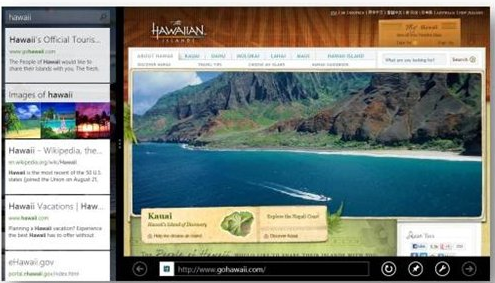Bing will receive a new look for Windows 8 users, the company’s Search blog reported. According to the post, the new Bing search will be available as an app, similar to Yahoo Axis, and offers a streamlined experience to find and preview content relevant to the user. While the adjustment is unlikely to impact search results, the app format will highlight visual content more predominantly than the usual Bing search.
The changes are only for the search app that will come pre-loaded on all devices offering Windows 8, including the Surface tablet from Microsoft set to launch next month. Searches from Bing.com will not include any of the layout features included within the Bing app.
David Lindheimer of Bing’s apps and experiences team wrote on the company’s blog that autocomplete will help app users find content and complete searches more quickly. The initial page shows off top results, related queries and the first few results from image search. Depending on the first result a user chooses, the app then offers entirely different viewing options customized to the type of content selected.
Image search will allow users to scroll through the relevant photos in a full-screen mode or view the actual image SERP.

With the Snap feature that first debuted in Windows 7, users can navigate to different web pages without leaving their results. The results page can be dragged to the side where it is converted into a column in the left or right third of the screen, while websites the user is browsing appear in the remaining two thirds. Users can navigate through all of the search results much faster with this tool since the search results are always open as they browse.
While the app doesn’t shift the way results are formulated, it places an emphasis on maintaining a top search result within Bing. Since users can view full web pages without leaving their SERPs, they’re more likely to find the most relevant content quickly. Furthermore, companies using content marketing to drive their search rankings must ensure their pages contain high-quality, attractive visuals above the fold.
The integration of the app with Windows 8 seems to make it entirely unnecessary to go to the actual Bing homepage, which could satisfy some users that often turn to Google search because of the ease with which it can be accessed. While early responses appear positive, the same challenge for Bing remains: How do you attract users away from Google?
Beyond the search results, the Bing app comes with a series of other capability for finding information and websites in certain categories, such as news, finance, weather and travel, as well as favorites. Additionally, social sharing is easier, as users can post content to Facebook and other social networks they use directly from the app. Social media marketing campaigns and search have seen increased crossover of late, with social contributing heavily to inbound links that inform search rankings as well as social integration on SERPs themselves for Bing and Google. On Bing.com, search results now include a social sidebar that includes data from most social networks to direct users to the most relevant content shared by friends and influencers related to their query.
The aggressive overhaul of Bing.com results and the launch of the app for Windows 8 users presents some interesting and useful new concepts for users. The integration of the app with Windows 8 seems to make it entirely unnecessary to go to the actual Bing homepage, which could satisfy some users that often turn to Google search because of the ease with which it can be accessed. While early responses appear positive, the same challenge for Bing remains: How do you attract users away from Google?
There’s little doubting that Bing has become a viable search player in recent years, but Google has maintained a commanding lead within the market. Brafton recently reported that July’s search figures from Experian Hitwise pegged Google’s search share at more than 65 percent of all queries.



